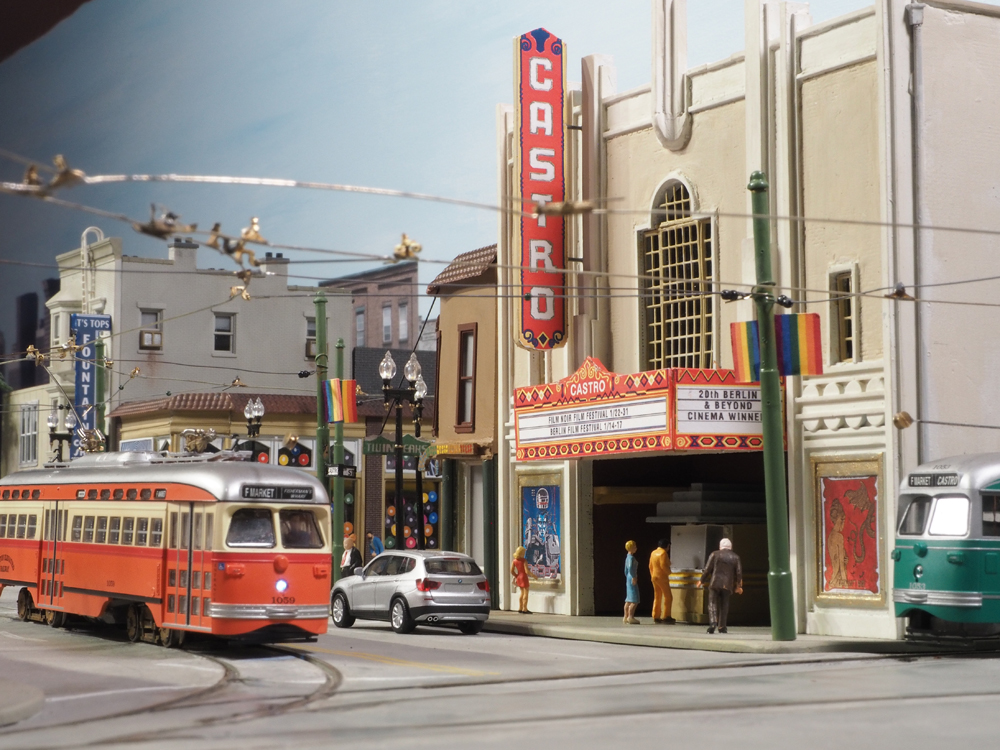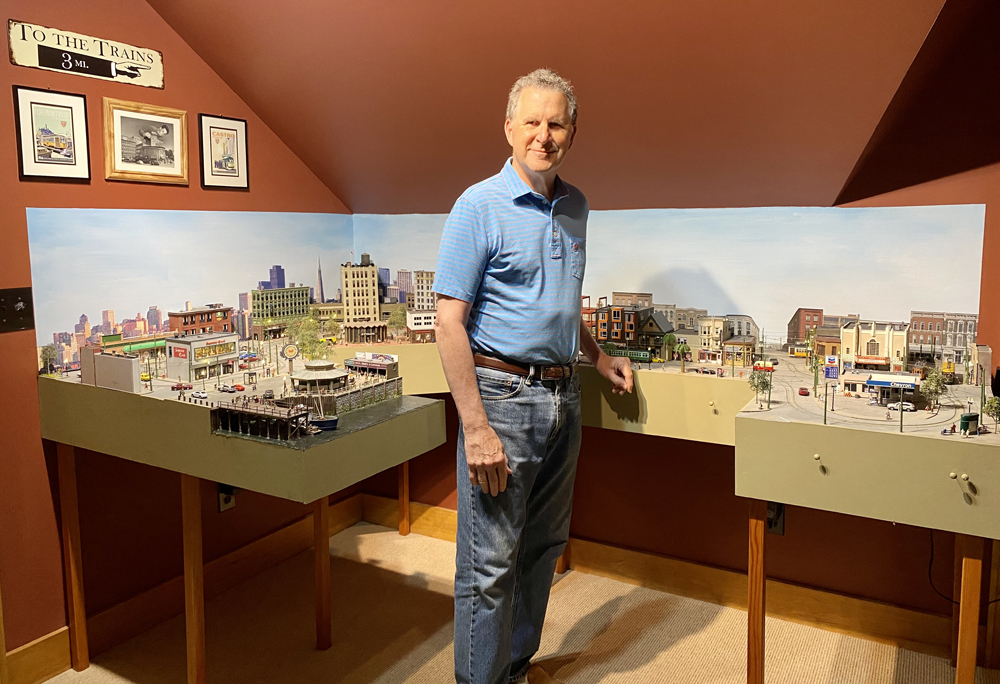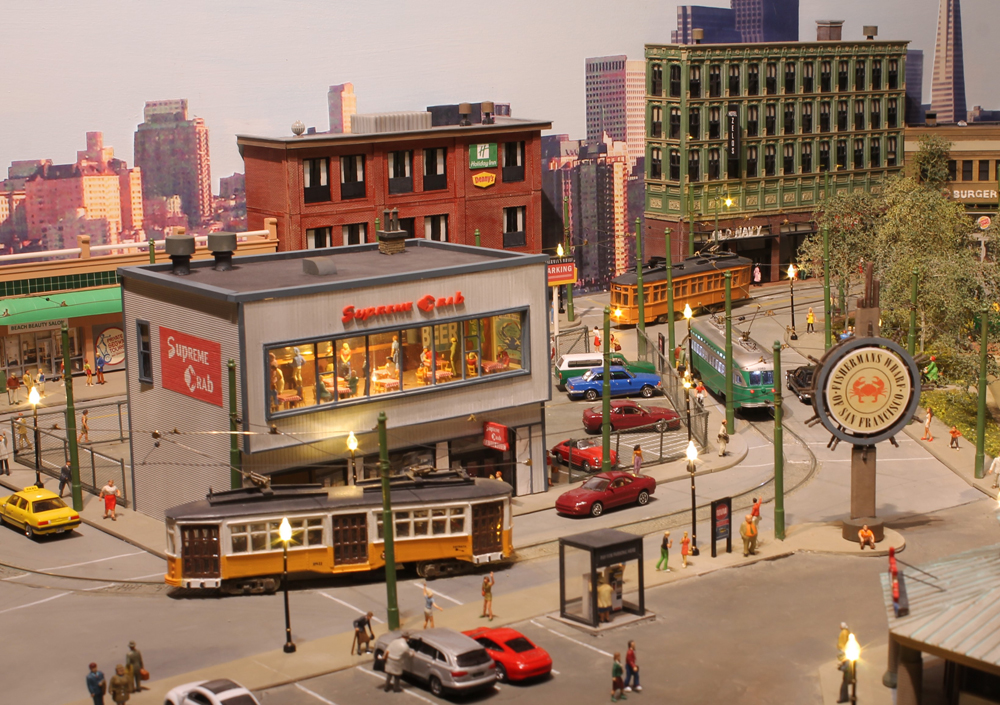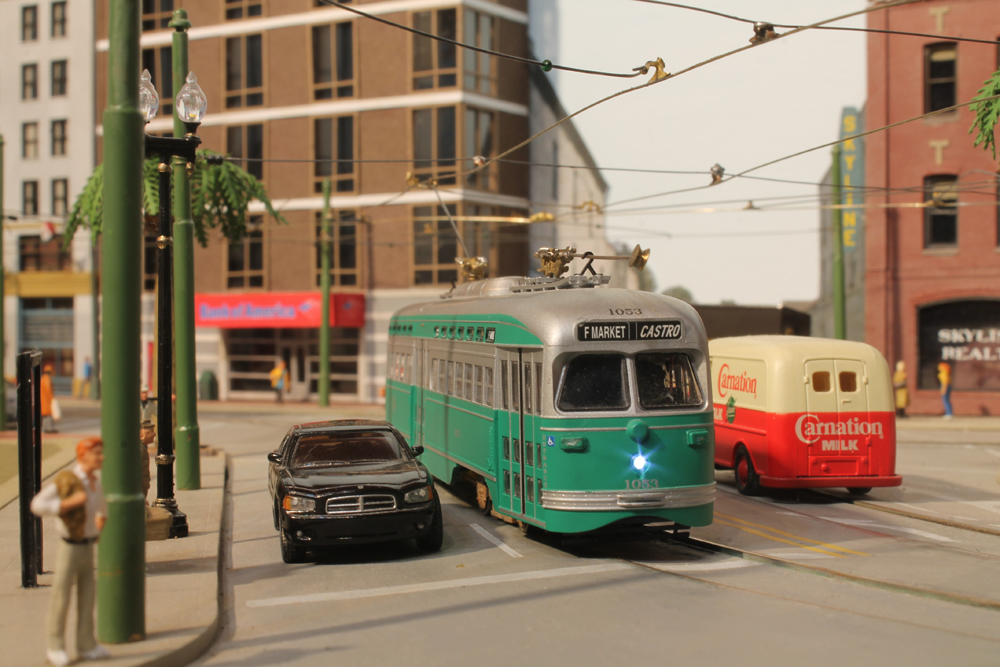What was your first train set (or locomotive)?
Dad and I set up my first train set on a sheet of plywood in the basement when I was 9. We rolled out “grass” paper over the plywood–it had the texture of sandpaper–and then we set up a figure eight over and under trestle set. We had two Atlas snap-switches to create a passing track, and I recall that the re-railer came in very handy. We finished the layout with Plasticville ready-built structures, and a few trees scattered here and there. It was so much fun watching the train and operating the switches.
Describe your model railroading philosophy in 6 words.
Two come to mind: Think small. After building several freight car kits, and a couple scratchbuilt cars from Model Railroader’s dollar model series, I was ready to build a layout. I bought the book 101 Track Plans for Model Railroaders and chose one that would fill my basement. Big mistake. I anticipated growing pains but couldn’t foresee the problem of biting off FAR more than I could chew. Frustration quickly set in, and it was painfully obvious I hadn’t read enough “how to” books for learning the various steps.
Couple that with a job move and I was ready to start over. I built several Campbell kits—still available and still great—so it was time to try again on a new layout. This time, before I started, I bought Kalmbach’s Building an HO Model Railroad with Personality. This book was the breakthrough I was looking for, as author John Olson gives a thorough, easy to follow guide for building a layout. Although the book is 40 years old—new products and techniques are continually being introduced–if you can still find a copy, buy it. It’s a wonderful primer on how to get started, and it gave me the confidence to try again. (If you can’t find it, there are several other introductory books. Look for one that is easy to follow with plenty of photographs. The idea is to show you how to do it without the various steps being intimidating.)
With the Olson book at the ready, my second layout was much smaller, less than 50 square-feet. I almost finished it—a job move, if you’ll pardon the expression, derailed my effort—but I felt a real sense of accomplishment laying track, adding scenery and watching trains run.
We moved three more times, and I kept sizing down. In 2001, I built an N-scale coffee table layout, and though it’s almost 25 years old, it still runs. My current layout is less than 35 square feet, and represents the F-line trolley system in San Francisco. The cars operate from overhead wire, and it’s very cool seeing them move across the layout getting power in the same way as the prototypes they represent.
While I know it’s fun to dream about having a basement empire, I’ve found it’s more fun seeing steady progress on a small layout as well as a view of the finish line, however dimly lit. Small layouts won’t overwhelm you. You can take your time and get into the little details that bring scenes to life. With the three small layouts I brought to completion, I felt a great deal of satisfaction and accomplishment.

A few other considerations to think about. Job moves are often inevitable, and early in my model railroading life I twice tried moving an unfinished model railroad. My experience is that it doesn’t work, no matter how much you plan, as it never quite comes together correctly in the new location. Additionally, large layouts are costlier to build. There’s more benchwork, wiring, track, and scenery materials to purchase, not to mention the cost of larger rosters of rolling stock and motive power. You’ll also likely need a more sophisticated system to power your layout. Finally, the time commitment for a large layout can be daunting. It took me seven years to build my current layout, and it’s only 35 square feet!
So, think small. I think you’ll be glad you did.
Download a track plan of the F Line.
What has been your biggest modeling success?

My biggest success is my current layout—a traction layout modeling San Francisco’s Muni F Line. Following a 15-year hiatus in the hobby, I began the layout in 2013. This was my second traction layout, and it took seven years to complete. Here I went for more realism, and each of the 29 structures represent an actual prototype. I was thrilled when Model Railroader featured my layout in the 2022 Great Model Railroads annual issue. I’ve had two other articles of the layout published, and even had a spot in the 2020 Model Railroader calendar. Indeed, it’s been a wonderful ride. I enjoy running the trolley cars and sharing my story with visitors.
What was your biggest modeling mistake?
Rushing trackwork. Slight imperfections—a small kink, poor transitions on curves, clearance issues on sidings—can be very frustrating. Locomotives and other rolling stock will invariably find your every trackwork mistake, however small. So, take your time with trackwork. It may take much more time than you think it should, but, trust me, you’ll be glad you took the time to be precise. The last thing you want to be doing is fixing a mistake after scenery has been applied. I found this out the hard way on my F Line layout. I handlaid track for the streetcars and then applied plaster to represent the streets. Before erecting the overhead wire, I tested the track and discovered one streetcar kept derailing in the same place. Sure enough, the gauge was slightly off, so I had to dig up the plaster, fix the trouble spot and then re-plaster. Had I been more careful initially, I wouldn’t have had this issue.
Testing can be tedious, but locomotives and cars come in different lengths, wheels and wheelbase dimensions. Trackwork that works for one locomotive may not for another due to these dimensional differences. So, assume nothing, test everything, and proceed slowly.
What’s your least favorite modeling task?
Working under the layout is uncomfortable, particularly if layout height is on the short side. In my case, the layout is on the second floor in a guest bedroom. The roof pitch forced me to lower the height of the layout by six inches to provide enough room for the backdrop. Accordingly, I didn’t have much space to work under the layout where I needed to run bus wires from the DCC system, solder track feeders, and wire accessories.
As it’s also dark under the layout, it’s helpful to have a battery powered head lamp handy that will illuminate the area you’re working on. This is particularly important if you’re doing any soldering. Soldering in a dimly lit, cramped space can be very tricky, but a head lamp will help greatly.
What project(s) have you been working on recently?

I’m currently installing working traffic lights to the layout. For a traction layout, traffic lights are comparable to signals on a conventional layout. The lights are controlled by a circuit board, and go through a complete cycle of green to yellow to red. On a four-way intersection the lights move in the opposite direction, creating a realistic effect. What’s cool is the streetcar operator (me) can realistically react to the lights as they change. The circuit board keeps the timing of the lights the same, so you must pay attention. When the lights turn red, you stop the car, and can only proceed when the light turn green.
WeHonest is the name of the company that supplies the lights. They are on eBay, and you can order direct from them. They also offer conventional signals, along with other model railroad accessories.
What advice would you give to a new hobbyist?

Model railroading is a wonderful, life-long hobby. I have two pieces of advice for someone considering model railroading.
First, invest in a few good tools. These include a hobby knife compatible with #11 blades, a steel straightedge, good quality acrylic hobby paints and brushes, a pin vise with an assortment of drill bits, tweezers for handling the small parts, a high-quality track cutter, a 40-watt soldering iron, rosin core solder and flux to help solder flow more easily, and some basic adhesives (white glue and CA). You’ll also need a couple power tools, including a drill and jigsaw. A circular saw can also come in handy for building benchwork. A well-lit work area is also very important.
Second, I’d start by building a simple structure and completing a freight car kit. Take your time, follow the instructions carefully, and you’ll get decent results. Try weathering each for more realism. I would then go to a home center and buy a 1’ x 1’ plywood board. Cement a single piece of track across the center of the board and add ballast between the ties. Create a scene using basic scenery materials—ground cover in various shades and textures, a couple trees, a figure or two, etc. Place your structure behind the track, and the freight car on the track. Add the trees, trying to frame the scene, a couple figures speaking with each other, and perhaps a vehicle parked next to the structure or on a road made from plaster or spackling compound crossing the track. Take a picture of the scene—you’ll see your mistakes and can then adjust accordingly. For example, is there a gap between the base of your structure and the plywood base? Or are there bare spots on the board? Add some ground cover to hide the gaps and bare spots. You’re looking for continuous improvement. By putting in sufficient effort into creating this little mini-scene, you’ll see what’s possible on something larger.
Experimenting like this is an excellent way to develop your skills. You’re now on your way, and just remember my biggest piece of advice: Have fun and think small.













